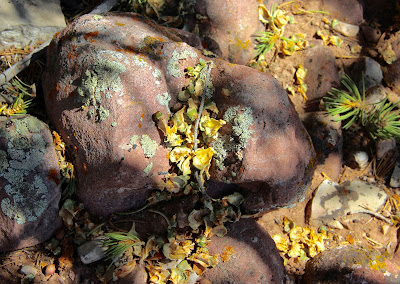 |
Next leg of the trip—down to the Green River, 2000 feet below the ridge crest.
|
This is not a local rock—not sandstone, siltstone nor shale. It’s hard tough quartzite, which is why it survived the long punishing journey that started 60 million years ago in the high country of a newly-created mountain range to the north. A fragment of bedrock—perhaps broken by folding, faulting, or frost—was carried many miles by streams, bumped and bashed, worn smooth and round, and left here.
 |
The rock itself is far older than the mountain range. It began as sand in a deep rift valley, 700 million years ago.
|
For maybe 30 million years, weathering and erosion chipped away at the mountains, reducing them to sand, dirt and pieces of rock. That’s typical—as soon as mountains rise, demolition begins. “Mountains seem massive, abiding and immutable … yet if we look carefully at rocks, if we use them to peer into the past and conjure up the world they came from, we find that mountains too are ephemeral.”
 |
The piles of sand, rock and dirt along the trail used to be part of a mountain range.
|
The amount of debris carried down and deposited was so immense that the mountain range was largely buried in its own rubble. Probably only the highest peaks stood above extensive gently-sloping surfaces. Then the land rose again—not as mountains, but the entire region. Erosion went back to work, this time exhuming the old buried landscape. It removed much of the debris deposited just a few million years before, but not all. Relic patches remain today on high surfaces—like the narrow precipitous ridge I walked. But unless things change, this too will be gone.
In the meantime, the quartzite boulder will have to wait a bit, because hundreds of years ago a pine seedling managed to get established and now has grown large. Its roots grew down into the pile of debris, circumvented the quartzite boulder, and trapped it. Though trail construction exposed the boulder, it can’t roll down to the Green River just yet. It has to wait until the tree dies and the roots decay. But given the scale of its life, I doubt that it feels the least bit impatient.
Now let’s consider the tree. It’s a pinyon—Pinus edulis (“pine edible”)—one of millions growing in the vast pinyon-juniper woodlands of the American West. Because pinyons live in country that is cold in winter and dry for much of the growing season, they grow slowly, never getting very big. But they are trees of great bounty, producing abundant large seeds beloved of squirrels and jays and little boys.
The sticky green young cones contain maturing seeds, on which wildlife will depend for winter survival (as did people in the old days).
With the right beak or teeth, older cones can be torn from the tree and pulled apart to get at nutritious seeds.
Left alone, cones open on the tree and seeds fall of their own accord.
Big tasty pinyon nuts are worth hunting for—even if you’re only five years old!
Monthly tree-following gatherings are kindly hosted by The Squirrelbasket.
Read the latest news here.









Oh yes, I remember seeing many Pinyon Pines on our trip this summer. Beautiful trees for specialized habitats. I've never eaten one of the nuts. Do you eat them fresh or dry them/toast them?
ReplyDeleteBeth--either way. I think they are tasty enough to eat straight out of the cone
DeleteAbsolutely fascinating!
ReplyDeleteIt almost seems the tree has collected the rock and can't bear to part with it. But then, I'm anthropomorphising...
The general view certainly shows why it's called Green River!
Brilliant information, and entertaining as always.
Thanks :)
Thanks, Pat, I appreciate the encouragement ... as always!
DeleteGreat post, Hollis. We had such a Pinyon/Stone environment on our New Mexico Property. The stone was only limestone though so over the years, the pine's roots broke it up! Never got any nuts in all our time there. The Packrats alwasy beat us to them. Now, the Japanese Bark Beetle has decimated the once very common Pinyon in New Mexico and Southern Colorado. It's such a shame they showed up along with the drought.
ReplyDeleteThanks, Richard! I hadn't heard about the Japanese Bark Beetle--so sorry to hear. The pinyons appear to be doing great in the Uintas area.
DeleteA fascinating post!! And the photos of the rock-n-root are quite something. I think they have a thing going, yes? :) I've always like pinyons. I've seen them in the West, though it's been a while. Loved this!
ReplyDeleteTina, I like it! definitely a thing going ;-) Thanks.
DeleteTree hugging!
ReplyDeleteGreat observation, Tineke!
Delete